For those of you who view this site regularly, you may recall a column I wrote last July about moving in which I lamented one of the more lunk-headed habits I’ve acquired since becoming a wine writer. It involved rocks:
“Yes, rocks. We like pretty rocks. We have a lot of them. My wife’s family has spent years in the Southwest and rocks, so to speak, are part of her heritage. I like to collect souvenirs from some of the many vineyards I’ve walked through–a dark green cube of schist from Coulée de Serrant, a wedge of limestone from Corton, a smooth galet from Chateau de Beaucastel. On the one hand these are really cool mementos; but when you’re wrapping rocks and packing them into a box that will weigh seventy-five pounds when you’re done, you are an idiot, plain and simple.”
Well, old habits are hard to break. Last month I was in Walla Walla, one of my favorite wine regions to visit. The food’s good, the community is very cool, and they’re making some pretty remarkable Merlots and Cabernets, not to mention killer Rhône varietal wines (most everyone thinks of the Syrahs, but this trip I tasted a number of fantastic Viogniers as well). I also love Walla Walla for the geology of the place; it’s as thrilling as any wine region on the planet. So I couldn’t help myself. I brought home some rocks.
Walla Walla’s geology is so bizarre that it remained a virtual mystery until the 1940s, when geologist J. Harlen Bretz decoded the surface clues and could finally account for the unearthly landscape that would one day become wine country. The examination of Walla Walla’s terroir is so nascent that there are still vast areas that are yet to be explored. (I can say with certainty that Eastern Washington is home to some the happiest geologists on earth.) Some exciting discoveries are being made, however, and I’ve got the rocks to prove it.
I’m going to start here, with Exhibit A:
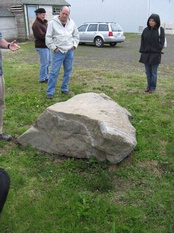
This one, dug up from a Walla Walla vineyard about six months ago, was a little too big to fit into my suitcase. It’s a big chunk of granite, and what’s interesting about it is that it has no business being in Eastern Washington because granite is not a geological feature of the area. So how did it get here?
Walla Walla lies within the Columbia Valley, which, about 10,000 years ago, experienced a series of floods so cataclysmic in nature that it changed the landscape of that region forever.
During the Ice Age, near the border of Canada and Montana, a huge lake formed when ice dammed the Clark Fork River. Periodically that ice melted, sending a mass of water the size of Lake Erie hurtling across eastern Washington–a wall of water half a mile high, traveling downstate at fifty miles an hour.
At certain points in the cataclysm, the floodwaters were stopped cold. (In what is now the Walla Walla AVA, that place was the Wallula Gap, on the Columbia River.) The waters backed up, dropping what they were carrying. That accounts for Exhibit A, which almost certainly was embedded in a floe of glacial ice and carried hundreds of miles to Walla Walla from Montana, only to sink in the slackwater.
Much of what is now Walla Walla was a lake, where deposits settled, then blew around like mad, and settled again. The Palouse Hills, on the valley’s northern border, are a sensuous invocation of those wind patterns. On the southern end of the appellation lies Seven Hills Vineyard, one of the oldest in the region, which is situated just above the former shoreline of an ancient lake. From there, as pictured here, you can almost make out its contours.
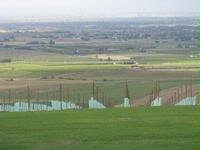
Turn south, the other way, and you see this:
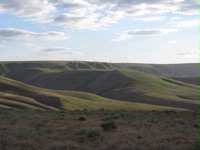
It’s one of the largest wind farms in the country. You could say that wind-driven soil deposits have dominated notions of Walla Walla terroir for the last 20 years; most vineyards are planted in these light, lean soils that have either been pushed here by the floods or blown here since, and fallen onto carpets of basalt.
But that’s changing. About twelve years ago Frenchman Christophe Baron was driving south of State Line Road (the Walla Walla Valley AVA extends into northern Oregon) when he noticed a pile of rocks, steaming off frost in the sun. In a flash, he imagined a Chateauneuf du Pape-style vineyard in the river cobbles. He went home to his father in Champagne and persuaded him to dole out his inheritance early.
These are what he saw:
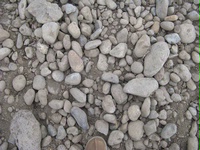
And these:
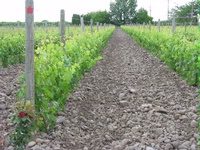
And these. Well, these are my rocks, pilfered from the first vineyard planted in the rocks, Cailloux:
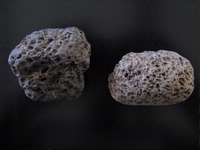
Cailloux Vineyard is planted on an ancient riverbed, which no one really saw having potential for grapes until Baron came along. The Syrah planted here tastes like no other Syrah in the valley. There’s a consistent spiced mocha, an earthy, savory quality that’s completely inimitable. The wines are fruity, of course, but unlike most wines in Washington (indeed, like most wines in the U.S.) these are not fruit-driven wines, which make them some of the most interesting in the country. Since Baron put vines in the rocks, many have followed; for the last decade, it has been the most compelling story of Walla Walla.
But it’s proving to be only part of the story. The other lies beyond the old shoreline.
Here’s Exhibit B.
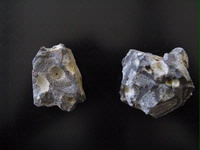
These are small samples of the rocks chipped from an enormous wall on the Oregon side of the valley, some fifteen feet of solid basalt. This basalt is the foundation rock of much of the area–a huge thick carpet of it was laid down during lava flows caused by the Cascade Range uplift. This wasn’t a single eruption, but a pattern of oozing that went on for thousands, if not millions of years. One of the basic geological forms in Walla Walla amounts to a thin, nutrient poor, wind-blown soil called loess that settles on the surface of this basalt. The loess, of course, has been the main feature of the soil. No one gave too much thought to the basalt. And that is what’s changing.
On a three-day visit to the Valley in May, I kept hearing people talk about “the Wall.” From beneath a windblown tent at a party I caught my first glimpse of the wall, a few ridges over, and it had me curious. Finally Marty Clubb, of L’Ecole No. 41, offered to take me for a closer look. Here are the photos:
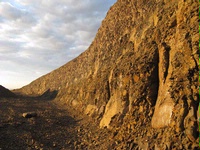
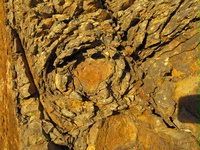
It’s more or less a solid piece of basalt, through which rainwater has been percolating for millions of years, leading to this textural, weirdly colorful decomposed rock.
You tell by the Wall’s weird colors and gradations and hollows that water has been seeping, collecting, oxidizing, 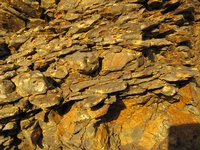 crystallizing minerals, or just staying put, lying in wait. A vineyard manager told me that on a few occasions he split open some of these large chunks of the wall and out would pour a few gallons of ancient water where it had been held thousands, millions of years in an almost impermeable basalt tomb.
crystallizing minerals, or just staying put, lying in wait. A vineyard manager told me that on a few occasions he split open some of these large chunks of the wall and out would pour a few gallons of ancient water where it had been held thousands, millions of years in an almost impermeable basalt tomb.
When the Wall was discovered, explained Clubb, it was quarried for roads leading through nascent vineyard land in the hills above Seven Hills. In some of these vineyards, the layer of windblown loess covering the underlying rock was so shallow, the owners decided to rip into the decaying basalt and create a kind of man-manipulated soil condition: loess plus cracked rock. We got to plod around in a newly ripped field, the surface of which looked like this:
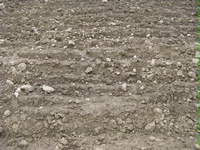
The vines are just now going into the ground, and there’s no telling just what this manipulation will produce in terms of flavors and texture in the wines, but it’s pretty certain it will be unlike anything else found so far in the Valley. I’ll give you an update in a couple of years; and by that time, it’s almost guaranteed that Walla Walla will have found another thrilling secret in its rocks.
